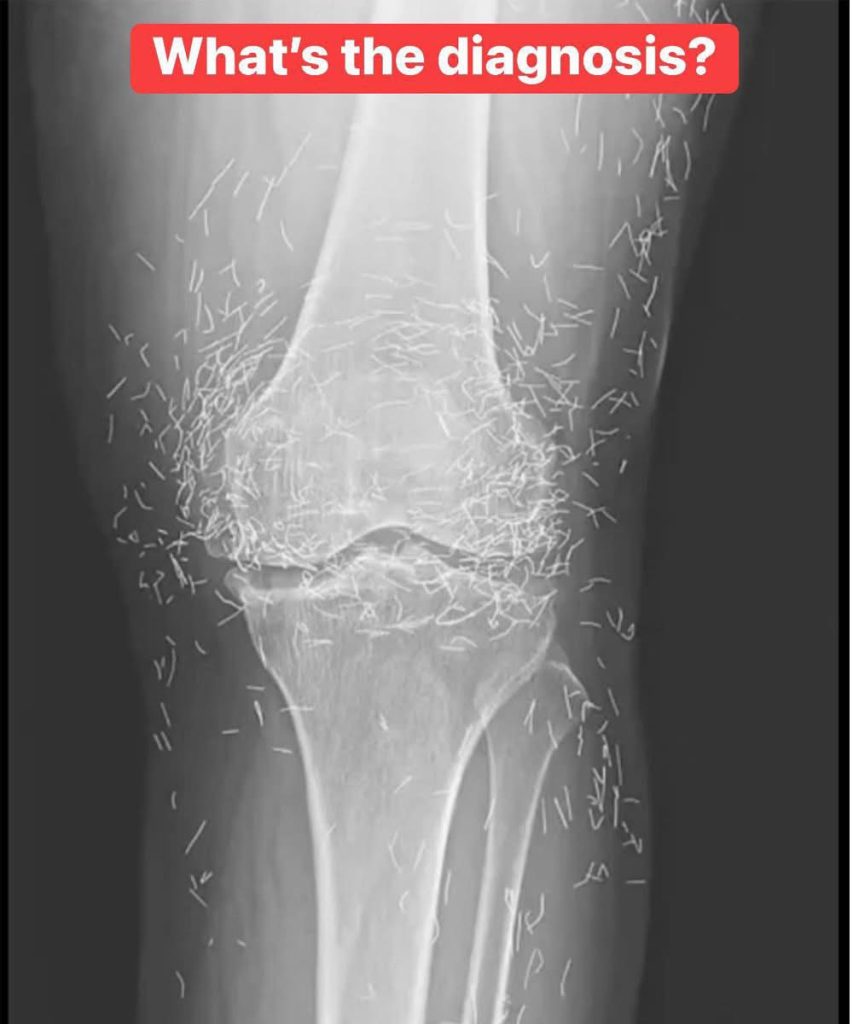X Ray Reveals Hundreds of Gold Needles in Woman s Knees

1. The Case
A 65-year-old South Korean woman suffering from osteoarthritis turned to acupuncture after conventional treatments—such as pain relievers and anti-inflammatory drugs—failed to relieve her knee pain and caused gastrointestinal discomfort ([Live Science][1], [Boston.com][2]).
2. Gold Thread Acupuncture
In her treatment, practitioners utilized gold-thread acupuncture. This technique involves embedding sterile gold needle fragments directly into tissues around the affected joints, with the intention of providing continuous therapeutic stimulation ([Boston.com][2], [Live Science][1]).
3. X‑Ray Findings
Doctors examining her X‑ray were taken aback by the sheer number of metallic fragments visibly embedded in her knees—resembling a “gold mine.” These fragments appeared as radiopaque lines scattered through the tissue, revealing a visually remarkable and rare medical finding ([Live Science][1], [Boston.com][2]).
4. Potential Risks and Caveats
- Complications from retained foreign objects: According to Dr. Ali Guermazi, a radiology expert at Boston University, leaving foreign objects in the body may result in inflammation, abscess formation, infection, and even obscured anatomical detail on imaging ([Live Science][1]).
- Imaging limitations: Retained needles can interfere with future imaging exams, such as MRIs. Although gold needles are generally MRI-compatible, other metals—especially ferromagnetic ones—could shift and damage tissues or vessels ([Live Science][1], [PMC][3]).
5. Cultural and Clinical Context
- Usage prevalence: While metal needle retention during acupuncture is uncommon in Western practice, it’s a known method in East Asia. Gold-thread acupuncture is particularly practiced in countries like South Korea as a form of long-term pain relief ([Live Science][1], [Boston.com][2], [Wikipédia][4]).
- Medical awareness matters: Clinicians and radiologists must remain aware of such practices. Recognizing retained acupuncture needles on imaging can prevent misdiagnosis and harm, and guide safer choices for future diagnostics ([PMC][3]).
6. Broader Examples
- Longevity of retained needles: In one rare case, a 94-year-old woman had gold acupuncture needles embedded in her back and hips for nearly 30 years, only discovered during imaging for unrelated reasons. Though clinically silent, their detection prompted caution regarding MRI considerations ([PMC][3]).
- Needle migration beyond joints: Another case revealed hundreds of retained needles that had migrated throughout the patient’s abdomen and pelvis. While no acute injury occurred, the foreign bodies posed potential future hazards and diagnostic confusion ([PMC][5]).
- Associated complications: A report documented recurrent cellulitis in a patient where gold needle fragments—initially implanted in the back—had migrated to her leg, likely contributing to inflammatory and infectious susceptibility in that area ([PMC][6]).
Summary Table: Key Insights
| Topic | Details
| Patient Case | 65‑year‑old with osteoarthritis; gold needles left in knees |
| Treatment Used | Gold-thread acupuncture for continuous stimulation |
| X‑Ray Findings | Hundreds of gold bends/fragments visible in knee tissue |
| Risks | Inflammation, infection, imaging interference, MRI hazards |
| Cultural Context | Common in some East Asian practices, rare in Western medicine |
| Other Cases | Long-term needles, migration, and related complications reported
Why This Case Matters
- Aesthetic Awe & Medical Curiosity: Doctors were astonished by the vivid X‑ray—a literal “gold mine” in the knees—making it both a medical oddity and a diagnostic spectacle.
- Safety & Diagnostics: Retained needles pose real risks: from infection and inflammation to diagnostic confusion, especially in imaging.
- Cross-Cultural Practice Awareness: As complementary therapies like gold-thread acupuncture become more widespread, medical professionals must understand their implications for patient care and imaging safety.
- Importance of Patient History: Thorough patient histories that include alternative treatments are vital for anticipating radiographic surprises or imaging contraindications like MRI.
